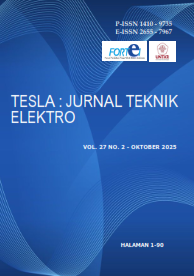DEVELOPMENT OF AN EARLY DETECTION SYSTEM FOR GAS TURBINE OIL LEAKS USING FUZZY LOGIC AND IOT
Main Article Content
Abstract
The gas turbine is one of the primary energy sources with high efficiency, where the lubrication system plays a crucial role in maintaining mechanical reliability and reducing operational risks. Oil leakage in the cooling tower can lead to overheating, reduced machine efficiency, and environmental contamination. This study aims to design an early detection system for oil leakage in a gas turbine cooling tower using fuzzy logic and the Internet of Things (IoT). The system integrates a photodiode sensor to detect light intensity changes and a DS18B20 temperature sensor, processed through an ESP32 microcontroller and displayed on an IoT-based real-time monitoring dashboard using MQTT protocol and Node-RED. The fuzzy Sugeno method classifies leakage levels into Normal, Light, Medium, and Severe categories based on the sensor readings. Laboratory testing shows that the photodiode sensor has a maximum deviation of 1.8%, while the temperature sensor error is 0.43%. The developed system successfully detects oil leakage concentration changes with latency under one second and provides accurate alerts through the IoT dashboard. This research contributes to preventive maintenance in industrial environments by enabling early oil leak detection, minimizing repair costs, and reducing environmental risks.
Abstrak
Turbin gas merupakan salah satu sumber tenaga utama dengan efisiensi tinggi, di mana sistem pelumasan berperan penting untuk menjaga keandalan mekanis dan mengurangi risiko operasional. Kebocoran minyak pelumas pada cooling tower dapat menyebabkan overheating, penurunan efisiensi mesin, dan pencemaran lingkungan. Penelitian ini bertujuan untuk merancang sistem deteksi dini kebocoran minyak pelumas pada cooling tower mesin gas turbin berbasis logika fuzzy dan Internet of Things (IoT). Sistem ini mengintegrasikan sensor photodioda untuk mendeteksi perubahan intensitas cahaya dan sensor suhu DS18B20, yang diproses oleh mikrokontroler ESP32 serta ditampilkan melalui dashboard pemantauan real-time berbasis IoT menggunakan protokol MQTT dan Node-RED. Metode fuzzy Sugeno digunakan untuk mengklasifikasikan tingkat kebocoran menjadi Normal, Ringan, Sedang, dan Parah berdasarkan pembacaan sensor. Pengujian laboratorium menunjukkan bahwa sensor photodioda memiliki deviasi maksimum sebesar 1,8%, sedangkan sensor suhu memiliki error sebesar 0,43%. Sistem yang dikembangkan berhasil mendeteksi perubahan konsentrasi minyak dengan latency kurang dari satu detik dan memberikan peringatan akurat melalui dashboard IoT. Penelitian ini berkontribusi pada peningkatan pemeliharaan preventif di lingkungan industri dengan memungkinkan deteksi dini kebocoran minyak pelumas, mengurangi biaya perbaikan, dan menekan risiko pencemaran lingkungan
Article Details

This work is licensed under a Creative Commons Attribution-ShareAlike 4.0 International License.
This work is licensed under a TESLA: Jurnal Teknik Elektro Creative Commons Attribution-ShareAlike 4.0 International License. 
References
[1] D. Chen and H. Wang, "Development of Smart Lubrication Monitoring System for Gas Turbine Engines," Tribology International, vol. 153, 106658, 2021. 10.1016/j.triboint.2020.106658
[2] L. Williams, "Preventive Maintenance Strategies for Reducing Oil Leakage," Journal of Maintenance Engineering, vol. 15, no. 2, pp. 23-34, 2022. 10.1016/j.jme.2022.03.002
[3] T. S. Liu and C. Y. Lin, "Real-time Oil Condition Monitoring Using IoT Technology," Sensors and Actuators A: Physical, vol. 315, 112345, 2021. 10.1016/j.sna.2020.112345
[4] A. Gupta and P. Kumar, "Photodiode Sensors for Industrial Fluid Monitoring: Performance Analysis and Applications," IEEE Sensors Journal, vol. 21, no. 8, pp. 9567-9575, 2021. 10.1109/JSEN.2021.3056789
[5] S. Lee and J. Kim, "IoT Solutions for Real-Time Monitoring of Industrial Equipment," International Journal of Industrial Engineering, vol. 27, no. 3, pp. 345-357, 2020. 10.1080/0740817X.2020.1751305
[6] N. Nasution, "Implementasi Sensor Fotodioda sebagai Pendeteksi Serapan Sinar Infra Merah pada Kaca," Jurnal Teori dan Aplikasi Fisika, vol. 3, no. 2, pp. 111-116, 2015. [Online]. Available: https://jurnal.fkip.unila.ac.id/index.php/JTAF/article/view/8527/6583
[7] DS18B20 Programmable Resolution 1-Wire Digital Thermometer Datasheet, Maxim Integrated, 2020. [Online]. Available: https://datasheets.maximintegrated.com/en/ds/DS18B20.pdf
[8] ESP32 Series Datasheet, Espressif Systems, Version 2.9, 2021. [Online]. Available: https://www.espressif.com/sites/default/files/documentation/esp32_datasheet_en.pdf
[9] M. A. Rahman et al, "Fuzzy Logic-Based Condition Monitoring System for Industrial Equipment," IEEE Transactions on Industrial Informatics, vol. 16, no. 4, pp. 2345-2354, 2020. 10.1109/TII.2019.2958473
[10] K. Tanaka and H. O. Wang, Fuzzy Control Systems Design and Analysis: A Linear Matrix Inequality Approach, John Wiley & Sons, New York, 2001.
[11] A. Imran, "Pengembangan Tempat Sampah Pintar Menggunakan ESP32," Media Elektrik, vol. 17, no. 2, pp. 45-56, 2020. 10.21063/ME.2020.202.45



